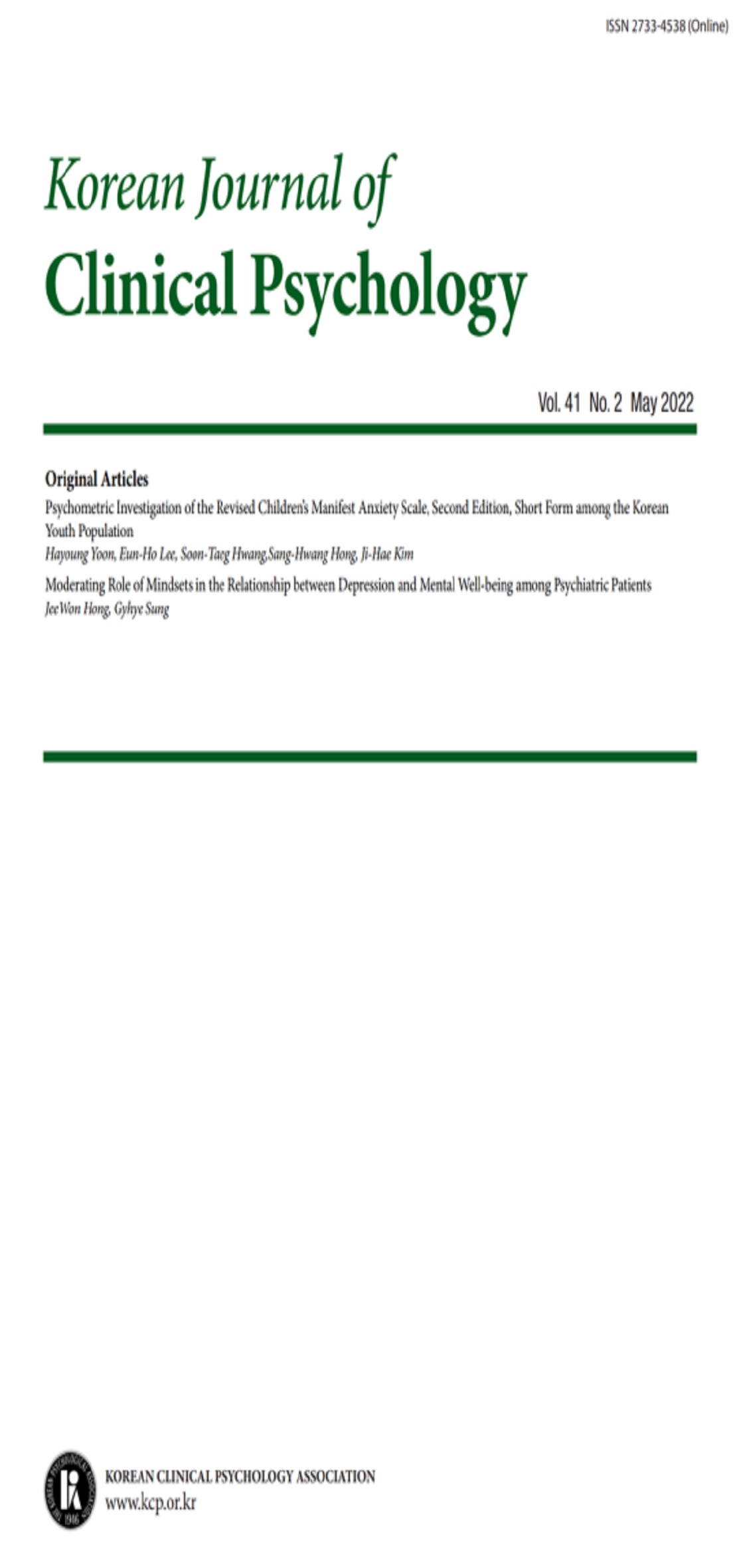open access
메뉴
open access
메뉴 E-ISSN : 2733-4538
E-ISSN : 2733-4538
This study examined the reliability and validity of the Korean version of the Social Skill Rating System (SSRS) for elementary school students, using a sample of 830 children in South Korea. This sample was divided into two groups. Data from one group were subjected to exploratory factor analysis (EFA), and data from the other group were subjected to confirmatory factor analysis (CFA) and were also used to test the concurrent validity of the K-SSRS. EFA yielded four factors, consisting of 23 items in total: empathy, assertion, self-control, and cooperation. CFA confirmed this factor structure and showed that it was similar to that of the original SSRS, but also showed that the K-SSRS scores explained more variance in the data than the SSRS scores did. The K-SSRS had adequate internal consistency. Its scores showed a significant and positive association with scores for self-esteem. In addition, girls showed higher social functioning than boys. In conclusion, the K-SSRS is useful for the assessment of social skills in Korean elementary school students and it has good psychometric properties.
교육과학기술부 (2012). 학생 정서행동 발달 선별 검사 및 관리 매뉴얼. http://www. mest.go.kr/web/285/ko/board/view.do?bbsId= 48&mode=view&boardSeq=28324
김용석, 홍지영 (2007). 한국어판 아동용 사회기술 척도의 개발과 평가. 한국아동복지학, 24, 178-206.
문성원 (2002). 인터넷 자살사이트에 의해 매개된 자살: 사례 중심의 탐색적 연구. 한국심리학회: 상담 및 심리치료, 14(2), 461- 485.
문성원 (2009). 심리적인 보호/위험 요인과 가족 구조 요인 그리고 청소년의 인터넷 이용 행동간의 관계: 성별 모형의 의한 접근. 한국심리학회지: 여성, 14(3), 731-758.
문성원, 김성식 (2004). 아동을 위한 다차원형 병리적 인터넷 이용 척도의 개발 및 타당화: 1부. 한국심리학회지: 발달, 17(3), 61- 77.
박난숙, 오경자 (1992). Methylphenidate 치료가 주의력결핍 과잉활동아의 인지․행동 및 사회, 학습, 정서적 적응에 미치는 효과. 한국심리학회지: 임상, 11(1), 235-248.
박효정, 정미경, 박종효 (2006). 학교폭력실태조사. 한국교육개발원
연세대학교 사회발전연구소 (2010). 한국 어린이-청소년 행복지수의 구축과 국제비교연구조사 결과보고서. 한국방정환재단.
양윤란 (2008). 사회공포증 증상과 사회기술의 관계에 대한 실험연구. 한국심리학회지: 임상, 27(4), 947-959.
오혜선, 채규만, 김명식 (2007). ADHD 성향 아동의 사회기술 향상 프로그램 개발과 효과 연구. 한국심리학회지: 임상, 26(1), 21- 37.
이기봉, 권순용, 박일혁 (2011). 저소득층 아동․청소년의 체육활동 참여 실태 연구. 한국청소년정책연구원.
이자영, 남숙경, 이미경, 이장희, 이상민 (2009). Rosenberg의 자아존중감 척도: 문항수준 타당도분석. 한국심리학회지: 상담 및 심리치료, 21(1), 173-189.
최진오 (2011). 초등학생들의 ADHD 성향과 사회기술 수준간의 관계. 아동교육, 20(1), 265-278.
Catalano, R. F., Berglund, M. L., Ryan, J. A. M., Lonczak, H. S., & Hawkins, J. D. (2002). Positive youth development in the United States: Research findings on evaluations of positive youth development programs. Retrieved August 22, 2002, from http://aspe.hhs.gov/hsp/ PositiveYouthDev99/
Cattell, R. B. (1966). The scree test for the number of factors. Multivariate Behavioral Research, 1, 245-276.
Cavell, T. A. (1990). Social adjustment, social performance, and social skills: A tri-component model of social competence. Journal of Clinical Child Psychology. 19(2), 111-122.
Consortium on the School-based Promotion of Social Competence (1994). The School-based promotion of social competence: Theory, research, practice, and policy. In R. J. Haggerry, L. R. Sherrod, N. Garmezy & M. Rutter (Eds.), Stress, Risk, and Resilience in Children and Adolescents. Cambridge: University press.
Demary, M. K., Ruffalo, S. L., Carlson, J., Busse, R. T., Olson, A. E., McManus, S. M., & Leventhal, A. (1995). Social skills assessment: A comparative evaluation of six published rating scales. School Psychology Review. 24(4). 648-671.
George, D. & Mallery, P. (2001). SPSS for Windows Step by Step. Simple Guide and Reference. Allyn & Bacon.
Gresham, F. M. & Elliot, S. N. (1990). Manual for the social Skills Rating System. American Guidance Service.
Horn. J. L. (1965). A rationale and test for the number of factors in factor analysis. Psychometrika, 30, 179-185.
Kaiser, (1960). The application of electronic computers to factor analysis. Educational and Psychological Measurement, 20, 141-151.
Kim, Y. S., Leventhal, B. L., Koh, Y. J., Fombonne, E., Laska, Lim,. E. C., Chen, K-A., Kim, S-J., Kim, Y-K., Lee, H., Song, D-H., Grinker, R. R. (2011). Prevalence of autism spectrum disorders in a total population sample. American Journal of Psychiatry, 168, 904-912.
Kohlberg, L. (1974). Education, Moral Development and Faith. Journal of Moral Education, 4(1), 5-16.
Min, H. J., Jon, D-I., Jung M. H., Hong, N., Song, M. A., Kim, Y. S., Harkavy-Friedman, J. M., Im, H-J. & Hong, H. J. (2012). Depression, aggression, and suicidal ideation in first graders: a school-based cross-sectional study. Comprehensive Psychiatry, 53(8), 1145- 1152.
NYC Department of Education. (2012). Discipline Code.
Rosenberg, M. (1965). Society and the Adolescent Self-image. Princeton, NT: Princeton.
Walker, H. M. & Shinn, M. R. (2002). Structuring school-based interventions to achieve intergrated primary, secondary, and tertiary prevention goals for safe and effective schools. In M. R. Shinn, H. M. Walker & G. Stoner (Eds.), Interventions for Academic and Behavior Problems II: Preventive and Remedial Approaches. NASP Publications
Weissberg, R. P., Kumpfer, K. L, & Seligman, M. E. (2003). Prevention that works for children and youth: An introduction. American Psychologist, 58, 425-432.
